First catalogued the by Greek astronomer Ptolemy in the 2nd century, the constellation of Cygnus is associated with the myth of Zeus and Leda in Greek mythology. It has 10 stars with known planets, with the brightest star in the constellation being Deneb, which is the 19th brightest star in the sky.
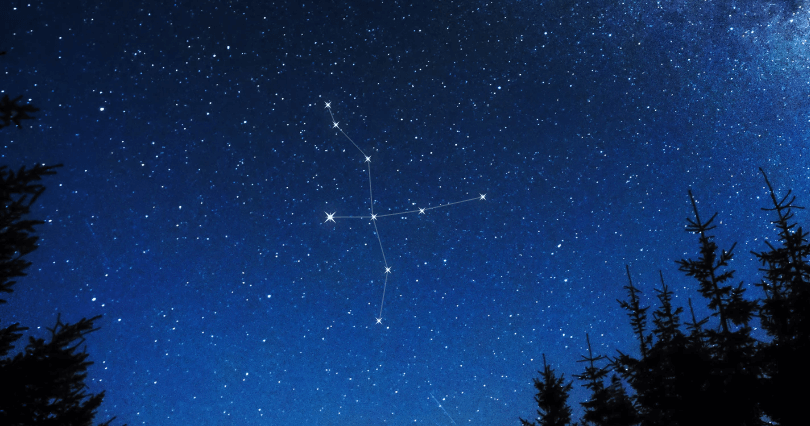
There are six named stars in the constellation. Their names, as approved by the International Astronomical Union (IAU), are Albireo, Aljanah, Azelfafage, Deneb, Fawaris and Sadr. Cygnus contains two Messier objects — Messier 29 and Messier 39 — and there are two meteor showers associated with the constellation: the October Cygnids and the Kappa Cygnids.
Cygnus Constellation History and Mythology
Constellation Cygnus is associated with several myths, although most notably with the myth of Zeus and Leda. Leda, the Spartan Queen, gave brith to two sets of twins after being seduced by the god Zeus, who had transformed himself into a swan. The twins were the immortal Pollux and Helen and mortal Castor and Clytemnestra. The immortal children were fathered by Zeus, and the mortal ones by Leda’s husband, King Tyndareus. Castor and Pollux are represented by the zodiac constellation of Gemini.
Cygnus is also sometimes seen as Orpheus, the Greek tragic hero who was murdered by the Thracian Maenads for not honouring Dionysus. Orpheus was transformed into a swan and placed next to his lyre in the sky, with the lyre being represented by the neighboring constellation of Lyra.
Something else that the Cygnus constellation is associated with are several people called Cycnus in Greek mythology. There are three who are most closely associated — Cygnus the murderous son of Ares who challenged Heracles to a duel and was killed, Cycnus, the son of Poseidon, who fought on the side of the Trojans in the Trojan War, was killed by Achilles and transformed into a swan after death, and Cycnus, a close friend of Phaeton, the mortal son of the Sun god Helios.
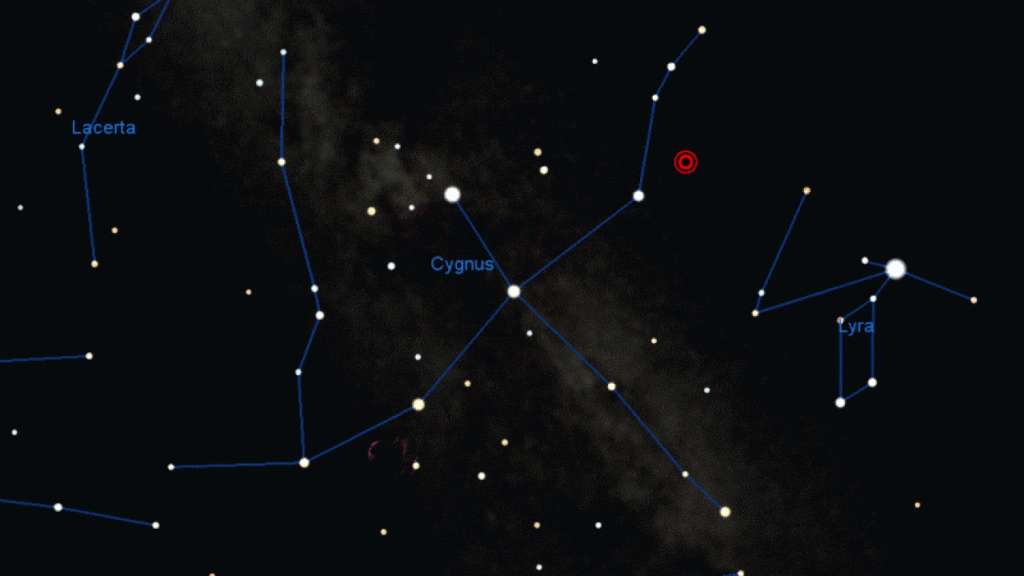
Location Of The Cygnus Constellation
Cygnus is the 16th largest constellation in the night sky and occupies an area of 804 square degrees. It lies in the fourth quadrant of the northern hemisphere (NQ4) and can be seen at latitudes between +90° and -40°.
Its right ascension is 20.62h and its declination is +42.03°. It is best visible at 9pm during the month of September. Cygnus is one of the most recognizable constellations of the northern summer and autumn.
The neighboring constellation to Cygnus constellation are Cepheus, Draco, Lacerta, Lyra, Pegasus and Vulpecula. It belongs to the Hercules family of constellations, along with Aquila, Ara, Centaurus, Corona Australis, Corvus, Crater, Crux, Hercules, Hydra, Lupus, Lyra, Ophiuchus, Sagitta, Scutum, Sextans, Serpens, Triangulum Australe and Vulpecula.
Notable Stars In The Cygnus Constellation
The most notable bright stars in the Cygnus constellation are the five that make up the Northern Cross asterism — Deneb, Sadr, Aljanah, Fawaris and Albireo. There are also other notable stars in the constellation.

Deneb
Deneb, also known as Alpha Cygni, is the brightest star in the Cygnus constellation and the 19th brightest star in the night sky. It is a blue-white supergiant belonging to the spectral class A2 Ia and has an apparent magnitude of 1.25. It has an an absolute magnitude of -7.0, making it one of the most luminous stars known. Deneb is almost 60,000 times more luminous than our Sun and has around 20 times the mass. It is also one of the largest white stars known.
The name Deneb comes from the Arabic dhaneb, meaning “tail,” from the phrase Dhanab ad-Dajājah, which means “the tail of the hen.” The star is approximately 1,400 light years away from us and, on Mars, is the North Pole star. Together with the stars Altair in the constellation Aquila and Vega in Lyra, Deneb forms the Summer Triangle, which is a prominent asterism in the summer sky.
The star has stopped fusing hydrogen in its core and is expected to explode as a supernova within the next few million years. It also serves as a prototype for a class of variable stars known as the Alpha Cygni variables.
Sadr
Sadr, also known as Gamma Cygni, is located at the intersection of the Northern Cross and belongs to the spectral class F8 lab, indicating that it is a supergiant. It has an apparent magnitude of 2.23 and is one of the brightest stars in the night sky.
The name Sadr comes from the Arabic word for “the chest,” şadr. It is also sometimes known by its Latin name, Pectus Gallinae, which means “the hen’s chest”. The star is located 1,800 light years away from Earth and is thought to be only about 12 million years old.
Sadr has twelve solar masses and a radius that is 150 times that of the Sun. It consumes its nuclear fuel more rapidly because of its mass. It is also surrounded by a diffuse emission nebula, IC 1318.

Aljanah
Aljanah, also known as Epsilon Cygni, is an orange giant star of the spectral type K0 III with an apparent magnitude of 2.480. It has a radius that is 11 times that of the Sun and is 62 times more luminous than the Sun. It is also 72.7 light years away from us.
Aljanah used to share the name Gienah with Gamma Corvi in the constellation Corvus, but the International Astronomical Union (IAU) approved the name Aljanah for the star in 2017. Gamma Corvi has retained the name Gienah. Both of these names come from the Arabic word janāħ, which means “the wing”, because both stars mark the wings of the birds in their constellation.

Fawaris
Fawaris, also known as Delta Cygni, is a triple star that will take over as the North Star for at least 400 years around the year 11,250. It is one of the stars that forms the Northern Cross. It consists of two stars lying close together and a third star located a bit further from the main pair. Together, the system has an apparent magnitude of 2.87 and is located around 165 light years away from us.
The brightest component in the star system is a blue-white giant belonging to the spectral class B9 III. It is a fast rotating star with a speed of 135 kilometres per second and is thought to be approaching the final stages of life on the main sequence. The closer companion to the brightest component is a yellow-white star belonging to the spectral class F1 V. It has an apparent magnitude of 6.33. The third component is an orange giant of the 12th magnitude.
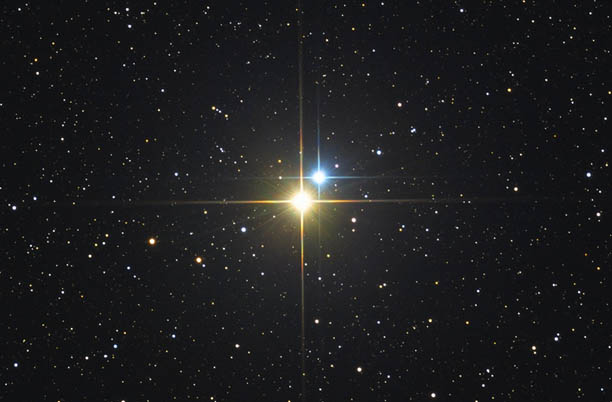
Albireo
Albireo, also known as Beta Cygni, is the fifth brightest star in the constellation of Cygnus and is one of the stars that forms the Northern Cross. It is located around 380 light years away from us and appears as a single third magnitude star to the naked eye. Its position marks the head of the swan in the constellation and is sometimes also known as “the beak star”.
The brighter component in Albireo is called Albireo A and is a binary star with two stars only 9.4 arc seconds apart. It is a yellow star with an apparent magnitude of 3.18 and the system belongs to the spectral class K3III .
The fainter component is Albireo B, a blue companion star with an apparent magnitude of 5.82 that belongs to the spectral type B0V. It is a fast-rotating Be star, with an estimated rotational velocity of 250 kilometres per second.
Zeta Cygni
Zeta Cygni is a located around 151 light years away from Earth and has an apparent magnitude of 3.20. It is a yellow star of the spectral class G8III and is believed to a core-helium fusing giant. It has a radius that is 14.7 times that of the Sun and it is 119 times brighter than the Sun.
Zeta Cygni has a 12th magnitude companion believed to be a white dwarf and creates a binary system with the star CCDM J21129+3014B.
Tau Cygni
Tau Cygni is a double star system that is located 68.2 light years distant from the Solar System. It is composed of a yellowish white subgiant star, GJ 822.1 A, which belongs to the spectral class F2IV, and a companion yellow main sequence star of the spectral type G0V.
The two components have apparent magnitudes of 3.84 and 6.44 respectively. The companion star is similar in size, luminosity and surface temperature to the Sun.
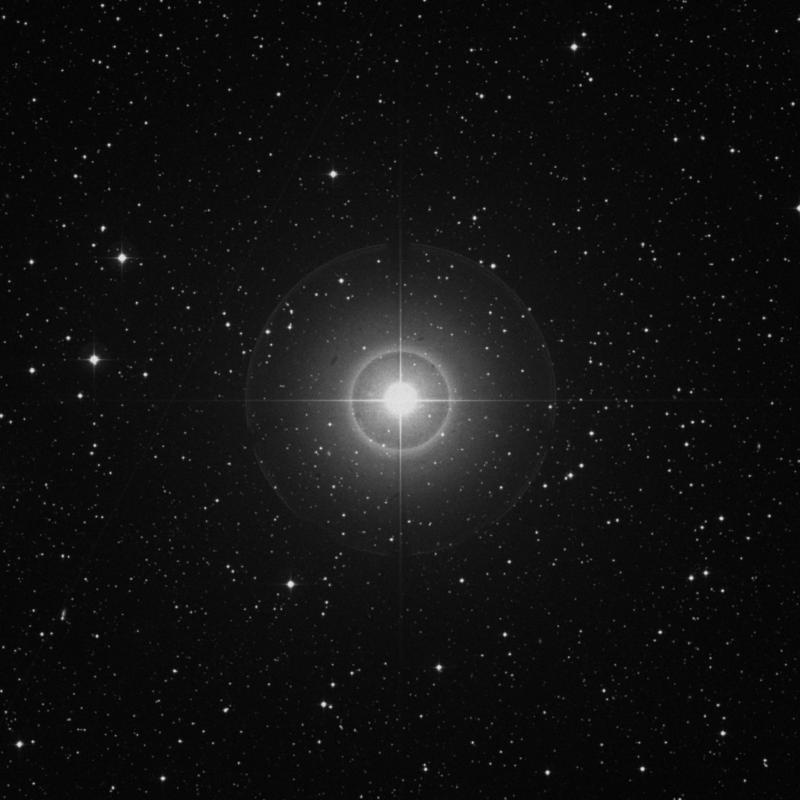
Kappa Cygni
Kappa Cygni has an apparent magnitude of 3.814 and can be seen by the naked eye. It is a giant star of the spectral type G9 III, located around 124.2 light years away from Earth. Its location marks the tip of the swan’s left wing in the constellation of Cygnus.
Kappa Cygni has a meteor shower associated with it — The Kappa Cygnids (KCG). They are a minor meteor shower that occur in August of every year and can be observed about five degrees north of the star.
Eta Cygni
Eta Cygni is an orange giant that belongs to the spectral class K0III. It has an apparent magnitude of 3.909 and is located approximately 139 light years away from us.
Pi Cygni
Pi Cygni consists of two star systems — Pi-1 Cygni and Pi-2 Cygni. Pi-1 Cygni belongs to the spectral type B3IV and has a visual magnitude of 4.67. It is also 1680 light years away from us. Pi-1 Cygni has a traditional name, Azelfafage, which comes either from the Arabic phrase al thīlf al faras, which means “the horse track” or from al ʽazal al-dajājah, “the hen’s tail”.
Pi-2 Cygni is a spectroscopic binary star whose main component is a B3-type blue giant. It has a magnitude of 4.23 and is almost 2,200 times more luminous than the Sun. It is around 1156 light years away from us. Pi-2 Cygni also has a few traditional names — Pennae Caudalis, which means “tail fathers” in Latin, and Sama al Azrak, which is Arabic for “the blue sky”.

Bessel’s Star (Piazzi’s Falling Star)
Bessel’s Star, also known as Piazzi’s Falling Star or 61 Cygni, is a double star system composed of a pair of two dwarfs belonging to the spectral types K5V and K7V, which orbit each other every 659 years. They have apparent magnitudes of 5.21 and 6.03.
61 Cygni is the 15th nearest known star system to Earth and is only 11.41 light years away from the Solar System. The brightest component in the system, 61 Cygni A, is the fourth nearest naked-eye star. In the year 20,000, it will come within nine light years of the Solar System.
Bessel’s Star is known for its large proper motion, which is the angular change in position over the course of time, as observed from the solar system’s centre of mass.
34 Cygni
34 Cygni, also known as P Cygni, is a variable star classified as a hypergiant luminous blue variable (LBV). LBVs are rare, only found in regions of intense star formation and usually short lived. They usually erupt into supernovae after only a few million years. 34 Cygni is approximately 6,000 light years away from Earth.
P Cygni is one of the most luminous stars ever discovered in the Milky Way. It belongs to the spectral class B1Ia+. It was first discovered by the Dutch astronomer Willem Janszoon Blaeu in August 1600. The brightness of 34 Cygni has fluctuated over the years. Today, it has an apparent magnitude of 4.8 with fluctuations up to 0.5 magnitudes.
39 Cygni
39 Cygni is an orange star that has an apparent magnitude of 4.436. It belongs to the spectral class K3III and is around 260 light years away from us. It has a surface temperature that is between 3,500 and 5,000 kelvin, and is cooler than the Sun. However, it is much brighter and larger than the Sun.
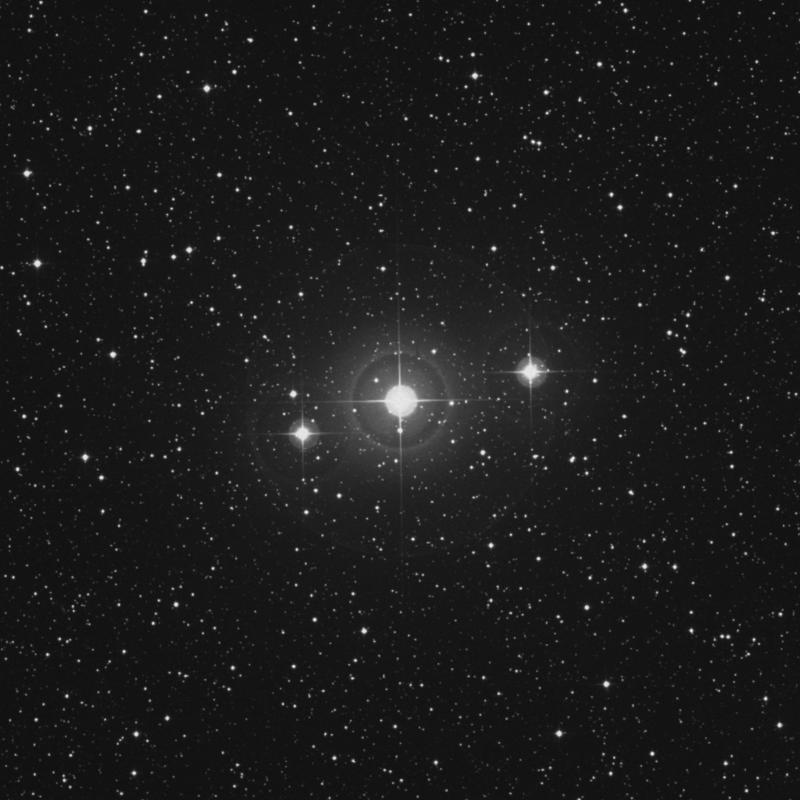
Theta Cygni
Theta Cygni is a main sequence star that belongs to the spectral class F3 V. It has an apparent magnitude of 4.490 and is located around 59.8 light years away from the Solar System. It is also between 0.6 and 1.9 billion years old. The main sequence star is four times as luminous as our Sun and has about 38 percent more mass.
There is a companion star in Theta Cygni which is very faint. It is located around three arc seconds away and is a red dwarf belonging to the spectral class M3 V. It has a magnitude of 13.03.
Theta Cygni is thought to have an extrasolar planet in its system. It is not confirmed, but the planet is believed to be twice the size of Jupiter.
16 Cygni
16 Cygni is a triple star composed of two yellow dwarfs similar to the Sun and a red dwarf. The two yellow dwarfs have apparent magnitudes of of 5.96 and 6.20.
16 Cygni is located around 70 light years away from the Earth. An extrasolar planet has been discovered in orbit.
Gliese 777
Gliese 777 is a yellow subgiant star belonging to the spectral class G6IV. It has an apparent magnitude of 5.71 and is located around 51.81 light years away from us. The star has a companion, which is dim red dwarf of the spectral type M4.5V with a visual magnitude of 14.40. It is located around 3,000 astronomical units away and is thought to be a binary star.
In 2005, the primary component was found to have two extrasolar planets in its system.
Ruchba
Ruchba, also known as Omega Cygni, is a multiple star system that consists of two visual doubles only a third of a degree apart.
Omega-1 Cygni is a hot subgiant belonging to the spectral class B2.5 with the visual magnitude of 4.95. It is around 910 light years away from us. Omega-2 Cygni is a red giant of the spectral type M2III and has an apparent magnitude of 5.22. It is around 400 light years from Earth.
The traditional name, Ruchba, comes from the Arabic phrase meaning “the hen’s knee”.
Deep Sky Objects
There are two deep sky objects in the constellation of Cygnus, as well as well-known galaxies and nebulae.
Messier 29
Messier 29, also known as M29 or NGC 6913, is an open cluster that can be seen with binoculars. It lies near the star Gamma Cygni, about 1.7 degrees to the south and a little east. It has an apparent magnitude of 7.1, with the brightest star having a visual magnitude of 8.59. The five hottest stars in the cluster belong to the spectral class B0.
Messier 29 is thought to be around 10 million years old. It is around 4,000 light years away from us and was first discovered by Charles Messier in 1764.
Messier 39
Messier 39, also known as M39 or NGC 7092, is an open cluster that is located about 800 light years from the Solar System. It lies two and a half degrees west and a degree south of the star Pi-2 Cygni.
M39 has an apparent magnitude of 5.5, with the brightest star having a visual magnitude of 6.83 and belonging to the spectral class A0. The brightest stars will soon evolve to the red giant stage.
It was first discovered by Charles Messier in 1764 and is thought to be between 200 and 300 million years old.

Fireworks Galaxy
The Fireworks Galaxy, also known as NGC 6946, Arp 29 and Caldwell 12, is an intermediate spiral galaxy that is located around 22.5 million light years away from us, near the border with the constellation of Cepheus. It is also very obscured by interstellar matter of the Milky Way.
With an apparent magnitude of 9.6, NGC 6946 was discovered by the German-born British astronomer Sir Frederick William Herschel on September 9, 1798. Since then, nine supernovae have been observed in the galaxy since — SN 1917A, SN 1939C, SN 1948B, SN 1968D, SN 1969P, SN 1980K, SN 2002hh, SN 2004et and SN 2008S.
Cygnus X-1
Cygnus X-1 is an x-ray source, famous for being one of the strongest ones seen from Earth. It is also the first X-ray source widely believed to be a black hole candidate — it has a mass that 8.7 times that of the Sun, yet is too compact to be any kind of known object other than a black hole.
First discovered in 1964 during a rocket flight, Cygnus X-1 is roughly 6,100 light years distant from Earth. It orbits a blue supergiant variable star, HDE 226868, and the two stars form a binary system.

North America Nebula
The North American Nebula, also known as NGC 7000 or Caldwell 20, is an emission nebula with an apparent magnitude of 4. It is very large, measuring about 120 by 100 arc minutes. However, it cannot be seen without binoculars because its surface brightness is pretty low. It is obscured by a band of dust, which determines its shape as we see it.
The North American Nebula is a part of the same H II region, (which is a large gas cloud in which star forming activity takes place), as its neighbouring nebula the Pelican Nebula. It lies about 1,600 light years away from Earth. It was named the North American Nebula as its shape resembles the continent of the same name.

Pelican Nebula
The Pelican Nebula, also known as IC 5070 and IC 5067, is another emission nebula. It is a part of the same H II region as the North American Nebula. The two nebulae are about 1,500 light years apart. It has an apparent magnitude of 8.0 and is located around 1,800 light years away from Earth.
The name of the nebula was given to it due to the fact its shape resembles that of a pelican. It can be found to the northeast of the star Danub.

Sadr Region
Sadr Region, also known as IC 1318, is an emission nebula. It is formed around the star Sadr that is located at the intersection of the Northern Cross in Cygnus.
Crescent Nebula
The Crescent Nebula, also known as NGC 6888, Caldwell 27 and Sharpless 105, is a an emission nebula. It’s formed by the strong stellar wind of HD 192163 (WR 136), which is a Wolf Rayet star in Cygnus. NGC 6888 has an apparent magnitude of 7.4 and is around 5,000 light years from Earth. It is also around 18’x12’ in size.
A Wolf Rayet star is a hot, old, massive star that is rapidly losing mass due to a fast stellar wind. This shell is formed when stellar wind from the star collides with the wind that the star ejected when it evolved into a red giant, around 400,000 years ago.

Cygnus Loop
The Cygnus Loop, also known as Sharpless 103, is a large supernova remnant. It spans almost three degrees across in the sky and forms an emission nebula. It is also a strong source of soft x-rays.
Veil Nebula
The Veil Nebula, also known as the Cirrus Nebula or Filamentary Nebula, consists of several components. The Western Veil (NGC 6960), the Eastern Veil (NGC 6992, NGC 6995, IC 1340) and Fleming’s Triangle (Pickering’s Triangle).
The Veil Nebula is the visual component of the Cygnus Loop and is around 90 light years in size. It is thought to be between 5,000 and 8,000 years old and is located approximately 1470 light years away from Earth.
The Western Veil, also known as NGC 6960 or the Witch’s Broom, forms the western-most part of the nebula. The Eastern Veil consists of three bright regions – NGC 6996, NGC 6995 and IC 1340.
Pickering’s Triangle is a faint region of nebulosity. It was named after Edward Charles Pickering, the director of the Harvard Observatory, which is where Williamina Fleming, who discovered it, made the discovery.
There are also two nebulae — NGC 6974 and NGC 6979 — that are located in a cloud at the northern edge of the Veil Nebula.
Extra Facts
- Cygnus may be a significant part of the origin of the myth of the Stymphalian Birds, one of The Twelve Labours of Hercules, along with other avian constellations near the summer solstice.
- The Chinese associate Cygnus with a myth — the one of the “magpie bridge” — Que Qiao.
- In Hinduism, the Cygnus constellation is correlated to the period of time between 4:24 AM to 5:12 AM, called the Brahmamuhurtha, which means “the moment of the Universe”. This is believed to be a highly auspicious time to meditate, do any task, or start the day.
- Known as the swan constellation, Cygnus is normally depicted with Delta and Epsilon Cygni as its wings.
- Deneb is at its tail and Albireo is at the tip of its beak.
Images:
- Cygnus 1 – https://www.universetoday.
com/20569/cygnus- constellation/ - Cygnus 2 – https://starregistration.
net/constellations/cygnus- constellation.html - Deneb – https://earthsky.org/
brightest-stars/deneb-among- the-farthest-stars-to-be-seen - Sadr – https://nineplanets.org/
sadr/ - Aljanah – https://www.star-facts.com/
tag/aljanah/ - Fawaris – https://theskylive.com/sky/
stars/fawaris-delta-cygni-star - Albireo – https://skyandtelescope.org/
observing/will-the-real- albireo-please-stand-up/ - Kappa Cygni – https://theskylive.com/sky/
stars/kappa-cygni-star - Bessel’s Star – https://freestarcharts.com/
61-cygni - Theta Cygni – https://theskylive.com/sky/
stars/theta-cygni-star - Fireworks Galaxy – http://annesastronomynews.
com/photo-gallery-ii/galaxies- clusters/the-fireworks-galaxy- by-robert-gendler/ - North American Nebula – https://apod.nasa.gov/apod/
ap130903.html - Pelican Nebula – https://www.constellation-
guide.com/pelican-nebula/ - Cygnus Loop – https://www.nasa.gov/
multimedia/imagegallery/image_ feature_688.html